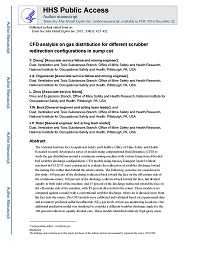Mining Publication: CFD Analysis on Gas Distribution for Different Scrubber Redirection Configurations in Sump Cut
Original creation date: July 2015
The National Institute for Occupational Safety and Health (NIOSH) has recently developed a series of models utilizing Computational Fluid Dynamics (CFD) to study gas distribution around a continuous mining machine with various fan-powered flooded bed scrubber discharge configurations. CFD models utilizing Species Transport Model without reactions in FLUENT were constructed to evaluate the redirection of scrubber discharge toward the mining face rather than behind the return curtain. The following scenarios are considered in this study: 100% of the discharge redirected back towards the face on the off-curtain side of the continuous miner; 100% of the discharge redirected back towards the face, but divided equally to both sides of the machine; and 15% of the discharge redirected toward the face on the off-curtain side of the machine, with 85% directed into the return. These models were compared to a model with a conventional scrubber discharge where air is directed away from the face into the return. The CFD models were calibrated and validated based on experimental data and accurately predicted sulfur hexafluoride (SF6) gas levels at four gas monitoring locations. One additional prediction model was simulated to consider a different scrubber discharge angle for the 100% redirected, equally divided case. These models identified relatively high gassy areas around the continuous miner which may not warrant their use in coal mines with medium to high methane liberation rates. This paper describes the methodology used to develop the CFD models, and the validation of the models based on experimental data.
Authors: Y Zheng, JA Organiscak, L Zhou, TW Beck, JP Rider
Conference Proceedings - July 2015
NIOSHTIC2 Number: 20046816
2015 SME Annual Conference and Expo and CMA 117th National Western Mining Conference - Mining: Navigating the Global Waters, February 15-18, 2015, Denver, Colorado. Littleton, CO: Society for Mining, Metallurgy, and Exploration, Inc., 2015 Jul; :136-142
See Also
- Analyzing Factors Influencing Struck-by Accidents of a Moving Mining Machine by Using Motion Capture and DHM Simulations
- Analyzing Factors Influencing Struck-By Accidents of a Moving Mining Machine by Using Motion Capture and DHM Simulations
- Development and Application of Reservoir Models and Artificial Neural Networks for Optimizing Ventilation Air Requirements in Development Mining of Coal Seams
- Modeling and Prediction of Ventilation Methane Emissions of U.S. Longwall Mines Using Supervised Artificial Neural Networks
- Modernization and Further Development of the NIOSH Mine Emergency Response Training System (MERITS), Phase 1
- New Simulated Gas Detector Offers Realistic Training for Mine Rescue Teams
- SPONCOM - A Computer Program for the Prediction of the Spontaneous Combustion Potential of an Underground Coal Mine
- SponCom - Spontaneous Combustion Assessment Software - 2.0
- Technology News 545 - NIOSH Updates Spontaneous Combustion Assessment Software
- Technology News 549 - MFIRE 3.0 - NIOSH Brings MFIRE into 21st Century
- Page last reviewed: 8/7/2017
- Page last updated: 5/9/2017
- Content source: National Institute for Occupational Safety and Health, Mining Program


 ShareCompartir
ShareCompartir
